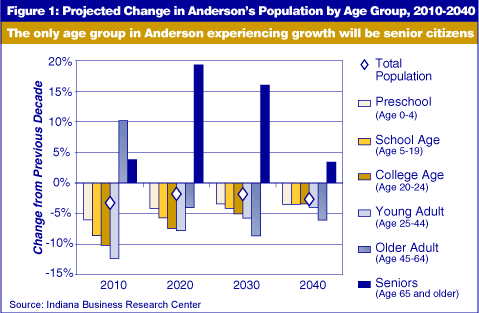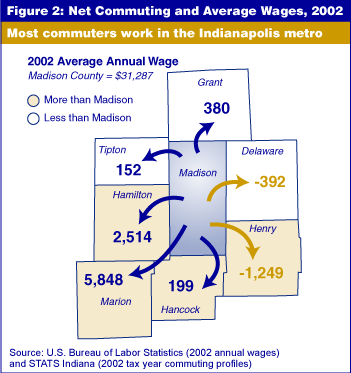The Anderson Metro Area
The Area
The Anderson Metropolitan Statistical Area (metro) is nestled snuggly in central Indiana between Indianapolis, Kokomo and Muncie. Consisting of Madison County—formerly the northeast quadrant of the Indianapolis metro area—the Anderson metro is now one of four single-county metro areas in the state.
As the 10th largest county in Indiana, Madison County had 132,068 residents as of July 2002. This represented a 1 percent decline over the Census 2000 number—a loss of nearly 1,300 people in two years due to domestic out-migration. However, residential construction in the area remains strong, with the number of building permits issued by November 2003 growing to 542, or 48 percent over 2002’s year-to-date totals. Several new housing subdivisions, including a 600-home development in Pendleton that will begin construction in the spring, indicate that construction will stay at these higher levels in 2004.
Nevertheless, population projections from the Indiana Business Research Center indicate continued migration out of the area, exacerbating the population decline. By 2020, the Anderson metro population is projected to drop an additional 4.1 percent, declining by over 5,300 residents. Between 2002 and 2040, Madison County is expected to have declined by nearly 11,000 residents.
Figure 1 shows that the only age group experiencing growth in the next 36 years will be the cohort age 65 and older, which will increase 23.8 percent by 2020 and 48.5 percent by 2040. While this “aging of the baby boom” should not surprise anyone, its combination with the ever-decreasing young adult population who are in their prime working years (projected to decline by over 7,000 people come 2020) could have serious implications on Anderson’s labor market.

Industrial Mix and Jobs
Total covered employment for the first quarter of 2003 showed 42,922 jobs in the Anderson metro area. Nearly half of all Madison County jobs were in manufacturing (19.3 percent), health care and social assistance (14.1 percent) and retail trade (13 percent). This closely resembles the state’s industrial mix, although with a somewhat smaller percentage employed in manufacturing and slightly higher percentages in the other two sectors.
While automotive manufacturing was formerly the mainstay of the Anderson economy, plant closures—coupled with phasing out the jobs of retirees—have begun to shift that paradigm a bit, leaving Anderson to explore opportunities in other sectors. Between the first quarter of 2001 and the same quarter of 2003, manufacturing employment declined by 1,491 jobs (15.2 percent).
More recent closures indicate Anderson’s decline in manufacturing employment is ongoing. Delco Remy America closed down their manufacturing facilities in March 2003 (while keeping their headquarters in the city), resulting in 350 lost jobs. Delphi Automotive Systems is likewise facing cutbacks. Nationwide, the company plans to reduce its workforce by about 5,000 positions (roughly 16 percent of its union employees), which Delphi expects to impact all of its plants. The extent that this will affect the Anderson operation remains to be seen. In addition, Smurfit-Stone Container, which produces corrugated cardboard containers, unexpectedly announced its plans to close in March of this year, leaving 143 people unemployed.
However, not all the news is bad. Guide Corp. remains one of the county’s largest employers with its production of automotive lighting systems. Home Design Products, a company with a plant in Alexandria producing plastic shelving, has purchased the former Magnequench facility in Anderson and plans to create 100 additional jobs for this new production line by 2005, in addition to moving its headquarters to Anderson from Indianapolis. Red Gold, a maker of tomato products, has also been expanding in both its Orestes and Elwood locations.
Anderson has high hopes for the Flagship Enterprise Center, a new endeavor between the city of Anderson and Anderson University. The center, which is to be completed in the fall, will nurture small business creation and facilitate the sharing of technical and educational expertise. Positioned as an innovative leader in education, business incubation, technology transfer and training, the state has declared it as one of five technology hubs in Indiana.
Commuting Patterns
Over 16,000 workers, 19 percent of Madison County’s labor force, commuted to another county to work in 2002 (see Figure 2). Although no longer part of the Indianapolis metro area, more than 70 percent of Madison County commuters drive to one of those 10 counties to work. An additional 10 percent commute into the Muncie metro, while nearly 7 percent are employed in the Kokomo metro area. The counties sending the most workers into the Anderson metro are Delaware (2,082) and Henry counties (1,565).

Income and Wages
Per capita personal income (PCPI) in the Anderson metro was $25,059 for 2001. This was nearly $2,500 less than the state and lower than that of Madison’s neighboring counties, with the exception of Grant County whose PCPI was just $22,872.
Madison County’s average annual wage per job was $31,287 for 2002, ranking it 25th among the state’s 92 counties and lower than half of its contiguous counties (see Figure 2). However, when looking at the average annual wage for a manufacturing job ($53,901), Madison County ranked eighth in the state and among the top 5 percent of counties nationwide.
Weekly wages for the first quarter of 2003 ranged from $1,158 in utilities to $191 in accommodation and food services. Management of companies and enterprises wages ($1,149) in the Anderson metro grew 24.5 percent since the first quarter of 2001, which is significant because the statewide wage for that industry declined by nearly that much. However, weekly management wages in Anderson still trail the state by over $150. The gap between Indiana and Anderson metro area earnings is most dramatic in the finance and insurance industry, as Madison County employees bring home a full $300 less each week.
Weekly manufacturing earnings ($1,046), on the other hand, grew just 2.8 percent during that same time period, but remain $169 above the state average. Education services is the only other industry where Madison County workers earn more than their counterparts in the rest of the state, a difference of $60 a week.
Rachel Justis
IN Context Managing Editor, Indiana Business Research Center,
Kelley School of Business, Indiana University
